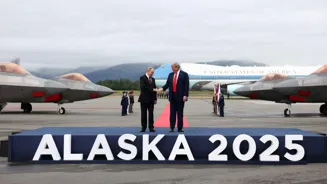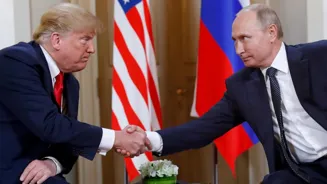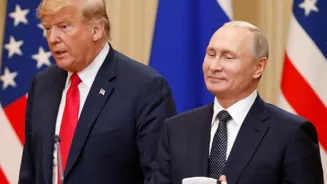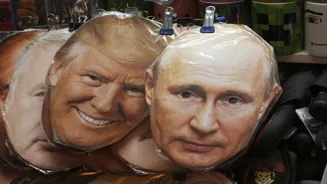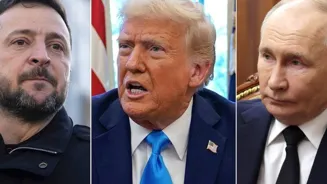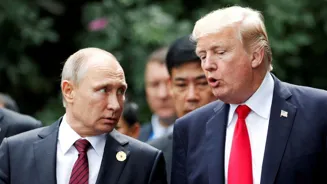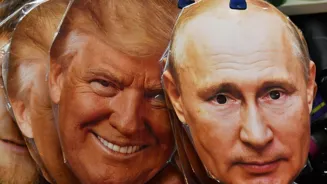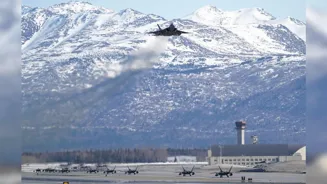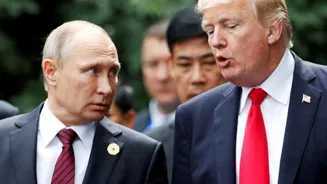Expectations were high that the summit might at least produce a framework for a ceasefire or set the stage for substantive negotiations.
Instead, the talks concluded earlier than planned and without a definitive agreement.
Both leaders highlighted “progress,” but neither specified what that meant, leaving observers and allies uncertain about what, if anything, had been achieved.
The summit carried strong symbolic weight — bringing Putin back onto US soil after
Yet the lack of concrete outcomes put into spotlight the lack of will in reaching a settlement to the ongoing war.
Trump set the stage in Alaska
The Anchorage summit was carefully choreographed, with fighter jet flyovers, a red carpet welcome, and the slogan “Pursuing Peace” displayed prominently.
For Trump, it was a chance to showcase statesmanship, while for Putin, the optics of being received with honours in the
Putin’s last visit to the US had taken place a decade earlier. Since the 2022 invasion of Ukraine, he had been effectively excluded from most Western capitals, with the International Criminal Court even issuing an arrest warrant against him.
Anchorage was chosen partly because the United States is not an ICC member, eliminating the risk of complications linked to that warrant.
Yet even as the two men exchanged
Inside the closed-door talks between Trump & Putin
Originally planned as a one-on-one session with only interpreters present, the meeting’s format was altered at the last moment.
Instead, each side brought two senior aides into the room. US Secretary of State Marco Rubio and special envoy Steve Witkoff joined Trump, while Putin was also flanked by top officials.
The White House provided no detailed explanation for this change, but it likely aimed to ensure clarity on commitments and prevent ambiguity that had surrounded Trump’s private meetings with Putin during his first term.
The discussion reportedly lasted just under three hours — shorter than anticipated — and ended without the ceasefire Trump had demanded in the run-up to the talks.
While both leaders emerged declaring that they had agreed on many issues, neither identified what those were.
“We had an extremely productive meeting, and many points were agreed to,” Trump said afterwards.
“There are just a very few that are left. Some are not that significant. One is probably the most significant, but we have a very good chance of getting there. We didn’t get there, but we have a very good chance of getting there.”
Putin echoed the sentiment, saying the two sides had agreed to “pave the path towards peace in Ukraine,” but provided no further clarity.
The missing Ukraine ceasefire
Throughout the weeks leading up to Anchorage, Trump had pointed out that a ceasefire was non-negotiable for a deal.
He suggested he would “walk” away if Putin did not agree to halt hostilities, even threatening “severe” consequences if the war dragged on. Yet by the end of the summit, no such outcome was announced.
In fact, Trump shifted responsibility toward Ukrainian President Volodymyr Zelenskyy, stressing in interviews after the summit that Kyiv had to accept difficult compromises.
“Gotta make a deal,” Trump said when asked what advice he had for Zelenskyy.
He indicated that discussions about potential territorial adjustments and US security guarantees had occurred and that “those are points that we largely have agreed on.”
This stance contrasted sharply with the Biden administration’s approach, which had pushed unwavering military and financial support for Ukraine while insisting on Kyiv’s sovereignty and territorial integrity.
Putin's victories
While Anchorage
First, his return to the US was in itself a breakthrough. Russian state television celebrated the handshake with Trump on the tarmac as “historic,” portraying it as evidence that Moscow had reemerged on the global stage despite Western attempts to isolate it.
Second, Putin left Alaska without offering any notable concessions. Instead, he reinforced his personal rapport with Trump, a relationship the American president
Third, Putin secured favourable public messaging. He praised Trump, declaring that he could “confirm” the US president’s claim that Russia would not have launched its 2022 invasion if Trump had been in office at the time.
Such remarks bolstered Trump’s narrative while simultaneously justifying Moscow’s past actions in the eyes of Russian audiences.
The Russian leader also scored a more personal victory: joining Trump in the armoured presidential limousine
Their brief ride together — without aides or translators — became a symbolic image of trust and camaraderie, though its contents remain unknown.
After years of being shunned in Europe and facing sanctions, restrictions, and legal threats, Putin was once again shaking hands with the leader of the world’s most powerful nation.
Trump’s choice to host him — and to do so with military honours, a red carpet, and public warmth — weakened the Western effort to diplomatically isolate Moscow.
Even if other European leaders remain unwilling to engage, the fact that Washington opened its doors carries far greater weight internationally.
This rehabilitation was evident from Putin’s demeanour. Smiling broadly as he peered from Trump’s limousine, his reentry onto the world stage was unmistakable.
Trump’s political gains
Trump may not have returned from Anchorage with a ceasefire, but he did extract political value from the event.
The summit provided a platform for him to denounce once again
Additionally, Trump gained momentum for his foreign policy agenda by positioning himself as the only Western leader capable of bringing Putin to the negotiating table.
Even the absence of a concrete deal allowed him to argue that progress had been made and that further meetings could eventually deliver results.
The idea of a follow-up summit in Moscow highlighted this point. When Putin suggested “Next time in Moscow” in English, Trump responded with interest: “Oooh, that’s an interesting one. I don’t know, I’ll get a little heat on that one. But I could see it possibly happening.”
If realised, such a visit would be the first by a US president to Russia since Barack Obama attended the 2013 G20 summit in St Petersburg.
Ukraine and Zelenskyy?
The person most directly affected by the summit — Ukrainian
Zelenskyy, addressing his nation just before the summit began, voiced scepticism about Moscow’s intentions.
“The war continues, and it is precisely because there is neither an order nor a signal that Moscow is preparing to end this war,” he said. “On the day of negotiations, they are killing, as well. And that speaks volumes.”
On the day of negotiations, the Russians are killing as well. And that speaks volumes. Recently, weʼve discussed with the U.S. and Europeans what can truly work. Everyone needs a just end to the war. Ukraine is ready to work as productively as possible to bring the war to an end,… pic.twitter.com/tmN8F4jDzl
— Volodymyr Zelenskyy / Володимир Зеленський (@ZelenskyyUa) August 15, 2025
In interviews after the
Yet the Anchorage summit made clear that Putin remains unwilling to negotiate directly with Zelenskyy under current conditions.
His suggestion to host Trump in Moscow, pointedly excluded the mention of the Ukrainian leader.
The summit’s key takeaways can be summarised as follows:
- No ceasefire: Despite
Trump’s insistence before the meeting, fighting in Ukraine continues.
- Symbolic gains for Putin: His return to U.S. soil marked a diplomatic breakthrough.
- Political opportunities for Trump: He used the event to dismiss past investigations and strengthen his image as a dealmaker.
- Uncertainty for Ukraine: Zelenskyy remains under pressure to “make a deal,” while Moscow shows no sign of halting military operations.
- Possibility of further talks: Putin invited Trump to Moscow, raising the stakes for
future negotiations.
The Alaska summit between Donald Trump and Vladimir Putin may not have produced a breakthrough, but it was nonetheless significant.
For now, the world is left with Trump’s own words: “There’s no deal until there’s a deal.”
With inputs from agencies
